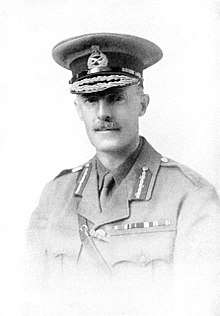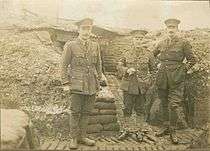George Carter-Campbell
Major General George Tupper Campbell Carter-Campbell, CB, DSO[2] (2 April 1869 – 19 December 1921) was a senior British Army officer who served in the Second Boer War and the First World War.[3]
George Carter-Campbell | |
|---|---|
 | |
| Born | 2 April 1869 Kensington, London[1] |
| Died | December 19, 1921 (aged 52) London, England |
| Allegiance | United Kingdom |
| Service/ | British Army |
| Years of service | 1889-1921 |
| Rank | Major General (1915) |
| Unit | Cameronians (Scottish Rifles) |
| Commands held | 2nd Battalion, Cameronians (Scottish Rifles) 94th Brigade 51st (Highland) Division |
| Battles/wars | Second Boer War World War I |
| Awards | Order of the Bath Distinguished Service Order Order of St. Stanislaus Légion d'honneur Croix du Commandeur Mentioned in dispatches |
| Relations | Thomas Carter (Rt. Hon., M.P., Secretary of State and Master of the Rolls), General George Campbell of Inverneill, C.B., K.A Admiral John Carter, Colonel Alexander Campbell of Possil, Major General Sir Archibald Campbell, General Sir James Campbell of Inverneill, Colonel Duncan Carter-Campbell of Possil, Willoughby Harcourt Carter |
Early life
A member of the Carter-Campbell of Possil family, Carter-Campbell was born in Kensington, the third son of Thomas Tupper Carter-Campbell of Possil and his wife, Emily Georgina Campbell, daughter of George Campbell of Inverneill.[3]
Military career
Carter-Campbell entered the Royal Military College, Sandhurst and was commissioned on 23 October 1889 as a second lieutenant into the Cameronians (Scottish Rifles). In the next decade he was promoted to lieutenant on 29 April 1892, and to captain on 2 November 1897. He served in the Second Boer War (1899–1902) as adjutant of the 2nd Battalion, which took part in the Ladysmith Relief Force, where he was present at the battles of Colenso (December 1899), Spion Kop (January 1900), Vaal Krantz and the Tugela Heights (February 1900). They served in Natal from March to June 1900, then in Transvaal east of Pretoria from July to November 1900.[4] For his services he was promoted brevet major on 29 November 1900, and twice mentioned in despatches.[5] Following the end of hostilities in South Africa, he returned to the United Kingdom in August 1902.[6]

On the outbreak of World War I, Carter-Campbell proceeded to France[7] with the 8th Division as second-in-command of the 2nd Battalion, Cameronians (Scottish Rifles)[8] and was wounded during the Battle of Neuve Chapelle[9] on 10 March 1915,[10] being awarded the Distinguished Service Order and also the Order of St. Stanislaus. He subsequently commanded the battalion until 23 September 1915, when he was promoted brigadier general to command the 94th Infantry Brigade. While holding the latter command, he was gazetted brevet lieutenant colonel and finally Brevet-Colonel.[11]
He assumed command of the 51st (Highland) Division[12] on 17 March 1918, taking over from Major General George Montague Harper, and was its GOC until he was transferred to the Rhine to take command of a brigade there, shortly before the division preceded home for demobilization. While in command of the 51st Division, Carter-Campbell was awarded the C.B. and the French Legion of Honour (Croix du Commandeur).[13]

Carter-Campbell was wounded during the First World War. After the war had ended, and he had recovered sufficiently, he was made GOC Northern Ireland in 1920.[14]
However, he died in 1921 at Queen Alexandra Military Hospital in London, with his war service being blamed for his premature death.[3]
Family
He married Frances Elizabeth Ward. They had two children, Dorothy Catherine Carter-Campbell b. 29 Oct 1909 and Duncan Maclachlan Carter-Campbell, 8th of Possil (5 Dec 1911 – Jan 1990).[15]
See also
- List of Légion d'honneur recipients by name
- Covenanter
- Cameronian
Notes
- England & Wales, Civil Registration Birth Index, 1837–1915
- Imperial War Museum (Great Britain), Malcolm Brown (1996). The Imperial War Museum book of the Somme. Sidgwick & Jackson, in association with the Imperial War Museum.
- "Obituary: Death Of Colonel Carter-Campbell". The Times. The Times Digital Archive. 21 December 1921. p. 14.
- Hart's Army list, 1903
- Arthur Mumby, Frank; David Hannay (1996). The great World War: a history. Volume 8. Gresham.
- "The War - Return of Troops". The Times (36842). London. 9 August 1902. p. 11.
- Great Britain. Parliament. House of Commons (1920). The Parliamentary debates (official report): House of Commons. H.M.S.O.
- William Sheehan (2009). Hearts & mines: the British 5th Division, Ireland, 1920-1922. Collins Press.
- Who was who: a companion to Who's who : containing the biographies of those who died during the period. A. & C. Black. 1967.
who was who carter-campbell.
- Moore, William (1970). The forgotten victor: General Sir Richard O'Connor, KT, GCB, DSO, MC,. Leo Cooper Ltd.
- Sir Arthur Conan Doyle (1920). A history of the great war, Volume 6. George H. Doran company.
- Malcolm Baynes, John Christopher (1989). The forgotten victor: General Sir Richard O'Connor, KT, GCB, DSO, MC,. Brassey's.
- James E. Edmonds (1995). Military Operations, France and Belgium, 1918. Issue 37 of Great War Series. Battery Press.
- Arthur Grenfell Wauchope (1926). A history of the Black Watch Royal Highlanders in the great war, 1914-1918. Volume 2. The Medici society limited.
- Beauclerk Dewar, Peter (2001). Burke's landed gentry of Great Britain: together with members of the titled and non-titled contemporary establishment. Burke's Peerage.
External links
| Wikimedia Commons has media related to People from Edinburgh. |
| Military offices | ||
|---|---|---|
| Preceded by George Harper |
GOC 51st (Highland) Division 1918–1919 |
Succeeded by Ewen Sinclair-Maclagan |